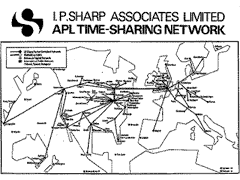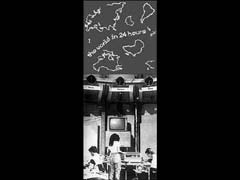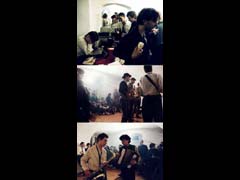| http://www.t0.or.at/~radrian/ |
|
The projects described below are selected to show the development of artists' use of telecommunications and to indicate the various media used and the increasing sophistication of their implementation. This summary concentrates on projects which included an Austrian participation or originated in Austria and in which I was personally involved and is therefore is by no means complete. In 1979 an invitation came from Toronto to take part in an on-line computer conference. A timesharing* company, I.P.Sharp Associates (IPSA), had just opened a local office in Wien and the company was providing free computer time for INTERPLAY, an art and telecommunications project in the program of "Computer Culture Canada". Interplay took place from about 20:00 to 22:00 on April 1, 1979 and linked 12 cities in Canada, U.S.A., Australia, Japan and Austria. There were actually 2 locations in Wien; Richard Kriesche and I were in the l.P.Sharp office in the Linke Wienzeile while Gottfried Bach, IPSA manager, had another terminal to the Funkhaus in Argentinierstr. for a live broadcast of the network conference in "Kunst Heute" (the forerunner of Kunstradio) on O1. In 1980 Bill Bartlett, the organiser of Interplay, sent out invitations for another project: an on-line expansion of the ARTISTS' USE OF TELECOMMUNICATIONS CONFERENCE at the San Francisco Museum of Modern Art (SFMMA). The media for this conference were Slow-Scan TV (SSTV) and Computer Conference. IPSA was once again providing free computer time and the network included San Francisco, Vancouver, Victoria, Toronto, Cambridge (MIT), Honolulu, Tokyo, New York and Wien. The Austrian contribution took place on Feb. 15, 1980 as part of the "Video Made in Austria" exhibition at the Museum des 20. Jahrhunderts with the support of Dieter Schrage. I was assisted in the organisation by Grita Insam and the participating artists included Valie Export, Richard Kriesche, Peter Weibel, Ernst Caramelle and Karl Kowanz. The problems of organising world-wide communications projects using air mail and telephone were becoming serious and, in the summer of 1980, Bill Bartlett and I began to put pressure on IPSA to develop a cheaper and more user-friendly E-Mail program for non-corporate and non-institutional users.* This resulted in the creation, by Gottfried Bach, of ARTBOX - a cheap and simple version of the IPSA "Mailbox". ARTBOX went through a number of versions untill about 1983 when it became formalised as ARTEX - the Artists' Electronic Exchange program- a "user-group" on the IPSA network. ARTEX had about 30 members and was used for the organisation of global projects and as a medium for art projects as well as for personal contact. It existed untill about 1990 when IPSA was purchased by Reuters and eventually closed down. In 1981 Tom Klinkowstein Joined ARTBOX and proposed a telefacsimile (FAX) project. FAX was virtually unknown then but we had heard of experiments between artists groups in North America. The project took place on Aug. 5,1981 between the Mazzo Club in Amsterdam and the Blitz Bar in Wien and was the first FAX project by artists in Europe. Christina Schopf from the Ars Electronica was present at the performance in the Blitz Bar and invited me to propose a telecommunications project for Ars Electronica 1982. The result was "Die Welt in 24 Stunden". DIE WELT IN 24 STUNDEN was the most ambitious project using low tech (telephone-based) communications equipment to be attempted untill that time. It involved setting up a global network of participating artists and groups that would each organise a contribution from their location using any or all of SSTV, Fax, Computer mailbox/ conference or telephone sound. The cities involved were: Vienna, Frankfurt, Amsterdam, Bath, Wellfleet, Pittsburgh, Toronto, San Francisco, Vancouver, Honolulu, Tokyo, Sydney, Istanbul and Athens. Each location was called from Linz at 12:00 local time - so the project began at 12:00 noon Central European Time on Sept.27 and, following the midday sun around the world, ended at 12:00 noon C.E.T. on Sept.28. In Linz I was assisted by Waltraut Cooper, Norbert Hinterberger and students from the class of Prof. Ortner at the Hochchule fur Gestaltung. In Wien the organisation was by Helmut Mark and Zelko Wiener at the Österreichische Kultur Service (ÖKS) Studio. The collaboration with Helmut Mark and Zelko Wiener continued and in 1983 we formed the verein BLIX together with musician/technician Karl Kubaczek and technician Gerhard Taschler. The support of the ÖKS also continued and that support was crucial for most of the subsequent projects in which Austrian artists participated. The first of these projects was "Telephone Music", a telephone concert organised by BLIX between Wien, Berlin and Budapest on April 15,1983. TELEPHONE MUSIC was an attempt to use the telephone (as the most universally available electronic communications medium) to create a common space for artists across the ideological barriers that divided Central Europe at the time - between "western" Wien, divided Berlin and "eastern" Budapest. At the ÖKS in Wien, Artpool in Budapest and Aufbau/Abbau in Berlin, we simply connected our telephones to amplifiers and played live music to each other for a couple of hours. WIENCOUVER IV (Dec. 4, 1983) was a much larger project which used the know-how gained from TELEPHONE MUSIC for a 3 hour exchange of sound and image (SSTV) between the ÖKS in Wien and the Western Front in Vancouver. I was at the Western Front as "Artist-in-Residence" and organised WIENCOUVER IV, together with Hank Bull, as part of my residency program. The Vienna organisation was by Helmut Mark, Zelko Wiener and BLIX. Two telephone lines were used for sound and SSTV and artists' bands, artists and performers were invited in both cities to perform live on-line. WIENCOUVER IV was, in effect, an experiment in 2-way interactive Television. In Vienna WIENCOUVER IV was preceeded by a live telephone concert with Warsaw and Berlin. In Vancouver Bill Bartlett, the real pioneer of low-tech artists' telecomm, made his farewell appearance in a communications project. As part of my Western Front residency I also organised the network for Roy Ascott's ARTEX project LA PLISSURE DU TEXTE, an experiment in collective authorship for the ELECTRA'83 exhibition in Paris. Participants in 11 cities around the world were assigned roles in a global fairy tale which took place between Dec. 11 and Dec.23, 1983. The roles were: Alma (Quebec) - BEAST; Amsterdam - VILLAIN; Bristol - TRICKSTER; Honolulu - WISE OLD MAN; Paris - MAGICIAN; Pittsburg - PRINCE; San Francisco - FOOL; Sydney - WITCH; Toronto - FAIRY GODMOTHER; Vancouver - PRINCESS; Vienna - SORCERER'S APPRENTICE. ARTEX was the medium for LA PLISSURE and IPSA provided 3 weeks free network time for the project. The participation in Vienna was organised by BLIX at the ÖKS Studio. For the Wiener Festwochen of 1984 BLIX organised KUNSTFUNK, an SSTV project for amateur radio at the Wiener Secession. For one week the upper rooms of the Secession were used as a radio studio and performance space. Each day a different artist or group installed or performed a work for SSTV transmission. Short wave was used for local (Europe, Middle east, Africa) and VHF to a local "ham" for retransmission via satellite to Pittsburgh. The project was organised, installed and managed by Zelyko Wiener, Gerhard Taschler and BLIX. The last project supported by the ÖKS was KUNST BTX, an experimental video text magazine. In 1985 the OPT introduced BTX in Austria. It was a much better system (CEPT2) than those in use elsewhere in Europe and the OPT provided the MUPID, a cheap computer capable of creating screen images in 4096 colours. With funding from the ÖKS, Zelyko Wiener developed the first issue of KUNST BTX for BLIX in August, 1985. The project was carried on by Gottfried Distl, Andrea Dee and Robert Adrian untill the end of 1986 when the ÖKS terminated support for art projects. At no time did the OPT offer any assistance, in fact they were actively hostile to creative use of BTX - which is probably the main reason it has failed. PLANETARY NETWORK was a part of Laboratorio Ubiqua at the Biennale di Venezia of 1986. Curated by Roy Ascott, Tom Sherman, Don Foresta and Tomasso Trini, PLANETARY NETWORK summed up all the low-tech telecommunications projects by artists since 1979. I organised the network on ARTEX for the last time. It was also the last comprehensive, multi-media, global network project. The networking of Personal Computers in BBSs and the increasing presence of FAX and other telephone peripherals in offices and homes made ARTEX and large-scale telecomm projects superfluous. It was also the last project for BLIX which drifted apart after the ÖKS changed its funding policy and closed the ÖKS Studio. The pioneer days were over .... Die Pionierzeiten waren vorbei ... http://www.t0.or.at/~radrian/ http://www.t0.or.at/~radrian/KUNSTFUNK/kunstfunk.html |




